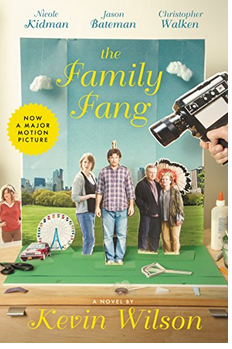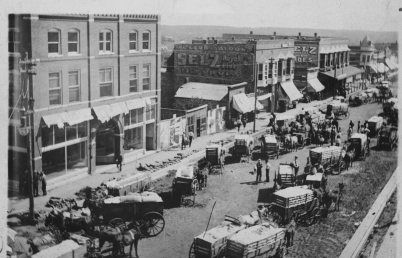Kevin Wilson published The Family Fang in 2012. I read the book then, but I did not write a blog about it because I was not keeping the blog as faithfully as I do now. Ann Patchett describes The Family Fang as “a comedy, a tragedy, and a tour-de-force examination of what it means to make art and survive your family…. The best single word description would be brilliant.”
The Fang family parents make “strange and memorable things” in the art world—performance art. They create a scene in public and then record the outcome. For example, they dress their son Buster who is nine as a female contestant in the Little Miss Crimson Clover beauty pageant as a way to challenge child beauty pageants. In another performance, Buster and older sister Annie are on a plane with their parents. Over the intercom, the father asks the mother to marry him, only to be turned down. The dysfunction is so great that the parents call the children Child A and Child B. The story is captivating and worth reading.

Wilson has followed The Family Fang with Perfect Little World. Maureen Corrigan, whose reviews on NPR are a delight, describes Wilson as “such an inventive and witty writer, that it was only after I’d finished Perfect Little World and was no longer caught up in the story, that I realized how many ideas he raises here, how many kinds of family arrangements he scrutinizes, among them biological, chosen, nuclear, communal, broken and bandaged. The utopian Infinite Family Project may be flawed from the get-go, but Wilson’s ‘perfect little world’ of a novel pretty much lives up to its title.”
The premise in Perfect Little World is simple: create a perfect little world. Dr. Preston Grind whose own parents, both psychologists, raised him under their own plan of child rearing. They wrote a book about the experiment with their son: The Constant Friction Method of Child Rearing. Preston’s parents loved and nurtured their son, but they also constantly created discomfort. They wanted to reinforce the notion that “the world was difficult and unpredictable, parental love was unwavering.”
The Grinds contended that “the world itself was harsh and unpredictable…. The failure of many parents was that they tried to create a false and ultimately unhelpful view of the world with regard to their children, seeking at all times to provide comfort and to make life free of complication.” Their method of “constant friction,” they contended, would make children “adaptable, more capable of handling whatever challenge might present itself.” Readers may strongly feel that the biggest challenge Preston has faced has been his own parents.
Preston shows such aptitude that by the time he is eight, his parents conclude their experiment is a success and they spend the rest of their lives touting the method of child rearing as a way to prepare children to be exceptional. Preston himself skips grades, receives a BA from Brown University when he is fifteen. He then receives a Ph.D. in clinical psychology from Harvard at twenty.
Dr. Grind, now in his thirties, still looks too young to be an accomplished clinical psychologist. He himself has written a book called The Artificial Village. That book catches the attention of Brenda Acklen, matriarch of the Acklen grocery store chain and billionaire. Brenda met her husband in an orphanage where they both found themselves when their parents could not take care of them. Unlike many stories of orphanages, Brenda and her husband, now deceased, experienced happy times at the orphanage, feeling that all the children there were their brothers and sisters. The children were well-treated, so Brenda’s memories of the time in the orphanage are happy.
Now, Brenda would like to fund an experiment with Dr. Grind at the helm: The Infinite Family. Mrs. Acklen envisioned “a family that is larger than just a husband and wife and their children. I’m talking about a place where everyone is connected and everyone cares for each other equally.” The project will last for ten years, and Mrs. Acklen hopes the friendships and relationships forged over the ten years will carry forward into the rest of the participants’ lives.
Izzie, Isabelle Poole, is fresh out of high school and pregnant by her high school art teacher, Hal Jackson, a member of a prominent and wealthy family. Hal says he loves Izzie and wants to marry her, but he never wants to have children. Izzie, already motherless since her mother’s untimely death, and fatherless in most senses of the word since her father works and then drinks himself into oblivion each evening, wants to have the baby. Because of the Jackson’s connections, Hal’s father being a well-known obstetrician, the family asks Mrs. Acklen to include Izzie and her baby in Dr. Grind’s Infinite Family project.
Dr. Grind and his grad assistants cull through numerous applicants and personal interviews, ultimately choosing nine couples, all expecting their first child around the same time. Izzie also is included as a soon-to-be single mother. Mrs. Acklen tells Dr. Grind that he needs “to make these families understand that we’re doing something important. That [Infinite Family project] is going to make their lives so much better than they would have been otherwise.”
Participants in the project all have separate housing, but the babies are kept in a communal nursery. Parents and the grad assistants take turn caring for the children twenty-four hours a day, rotating duties. The children do not know which parents are theirs since they are all cared for equally by all members of the community. When the children are five, five years into the Infinite Family project, the parents will be revealed to the children and the children will then join their parents in the individual homes.
Participants in the project receive free food and housing and education. The adults can choose what they would like to do. For example, Izzie, fresh out of high school, pursues a degree in art. Julie, already a published author, uses her time to write a new book. Jeremy and Callie grow organic vegetables for the project’s kitchen. All the parents and fellows take turns cooking.
Izzie is particularly fond of working in the kitchen because she has worked in a barbeque café and has learned how to prepare perfect barbeque pork. At the café, she also forged a strong friendship with Mr. Tannehill, the man who prepares the barbeque. In fact, their bond is so strong that Izzie names her son for Mr. Tannehill: Cap. Mr. Tannehill continues to figure in Izzie’s life, becoming a grandfather to Cap.
As readers might expect, the Infinite Family project runs along smoothly for some time, but cracks begin to appear in the relationships. Suffice it to say, these people are human and subject to foibles. Add to those shortcomings the death of Mrs. Acklen who has funded the project. When her granddaughter Patricia takes over, Dr. Grind is dismissed. All the participants receive $100,000 to start their new lives. They have all taken advantage of the educational opportunities offered during their time in the Infinite Family project. The project is ending at year seven.
Readers may or may not be surprised by the ending of the story, but they will feel satisfied that the story has ended with a clear direction toward the future.
Kevin Wilson may seem like an unlikely novelist. He has a master’s degree in computer science, software engineering, and multimedia systems. He has taught college classes and tutored students in computer science. He now teaches fiction at the University of the South in Sewanee, Tennessee. Learn more about Kevin Wilson at his Web site: http://www.wilsonkevin.com/.
At the following link, listen to Kevin Wilson reading from The Family Fang:

























